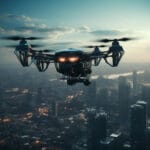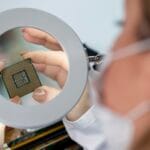FPGA Insights has engaged in an exclusive interview with Balaji, FPGA design Engineer at Data Patterns
Q1) Can you provide an overview of your experience with FPGA design projects mentioning a few that you’ve worked on, starting with a brief introduction?
Yeah. I’ve been working as an FPGA DESIGN Engineer in the defense sector for the past 3 years. And I did some interesting projects like High-frequency Band Receivers, cockpit display modules, modems, etc. Interface or protocol handled like ARINC, PCIe, Ethernet, JESD, SPI, etc.
Q2) Can you explain the benefits of using FPGAs over other types of processors?
FPGAs allow for hardware customization, enabling the implementation of specific functions in hardware, which can result in faster and more power-efficient processing compared to general-purpose processors. It can perform parallel processing on a massive scale, making it suitable for applications where parallelism is crucial, such as signal processing and high-performance computing. In certain applications, FPGAs can achieve better power efficiency compared to traditional processors because they can be optimized for the specific tasks they are designed to perform. FPGA can minimize processing delays due to their ability to directly implement hardware functions, making them suitable for applications that require low-latency responses, such as communications and control systems.
Q3) What are the most significant trends observed in the FPGA industry over the past year? How will these trends shape the industry’s future?
FPGAs play a role in 5G infrastructure nowadays for tasks such as baseband processing and network acceleration. The rollout and expansion of 5G networks and wireless technology are expected to drive demand for FPGA solutions. It has been increasingly integrated into AI and machine learning applications, providing hardware acceleration for complex computations. This trend is likely to continue as AI/ML workloads expand.
Q4) How do you see FPGA development evolving to meet the demands of modern applications and complex workloads?
FPGA development is likely to evolve by incorporating advancements in high-level synthesis tools, making it more accessible to software developers. Additionally, there may be an increased focus on energy efficiency, heterogeneous computing, and customization to address the demands of diverse and complex workloads in areas like AI, data analytics, and edge computing, defense. The integration of FPGA with other technologies, such as AI accelerators and quantum computing, may also play a role in shaping its future development.
Q5) Key drivers behind the increasing adoption of FPGAs in various applications and industries?
As previously discussed-
1. Performance Acceleration: FPGAs offer hardware-level parallelism and can be customized to accelerate specific algorithms, providing significant performance gains compared to traditional processors for certain applications, such as signal processing, image recognition, and cryptography.
2. Flexibility and Reconfigurability: FPGAs are reprogrammable, allowing for flexibility in adapting to changing requirements without the need for hardware redesign. This makes them suitable for applications with evolving standards and specifications.
3. Low Latency and Real-time Processing: FPGAs can execute tasks with low latency, making them well-suited for real-time processing applications like communications, control systems, and high-frequency trading.
4. Energy Efficiency: In certain scenarios, FPGAs can achieve better power efficiency than general-purpose processors, especially when optimized for specific tasks. This makes them attractive for applications where power consumption is a critical factor.
5. Parallel Processing for Big Data and Analytics: FPGAs excel in parallel processing, making them valuable for accelerating tasks related to big data analytics and processing, where parallelism is essential for handling large datasets efficiently.
6. Collaborations and Ecosystem Development: Collaborations between FPGA vendors, software developers, and end-users have led to the development of comprehensive solutions, fostering the adoption of FPGAs in diverse applications and industries.
Q6) Sectors that stand to benefit the most from FPGA integration, and why?
1. Telecommunications: FPGAs are used in baseband processing for wireless communication systems and can be reconfigured to support various standards. They provide the flexibility and performance needed for tasks like channel coding, modulation, and beamforming in 5G networks.
2. Automotive sector: FPGAs are used for hardware acceleration in automotive applications, including advanced driver-assistance systems (ADAS), image recognition for autonomous vehicles, and in-vehicle networking. Their ability to handle parallel processing and low-latency requirements is crucial for automotive safety systems.
3. Aerospace and Defense: FPGAs are employed in radar and sonar signal processing, communications systems, electronic warfare applications cockpit Displays, satellite modules, etc. The ability to reconfigure FPGAs enables rapid adaptation to changing mission requirements and evolving threat scenarios.
4. Industrial Automation: FPGAs are used for real-time control systems, programmable logic controllers (PLCs), and robotic control in industrial automation. Their ability to implement custom hardware accelerators enhances the efficiency of control processes.
Q7) The role of FPGAs in accelerating AI applications and advancements expected in the near future?
Future FPGAs are expected to have better integration with popular AI frameworks like TensorFlow and PyTorch, simplifying the development and deployment of FPGA-accelerated AI applications. Dedicated AI co-processors within FPGAs are likely to become more common, further optimizing the hardware for specific AI workloads and improving overall performance.
Q8) Ensuring the security and integrity of FPGA designs, especially in sensitive applications like finance and defense?
Ensuring security and integrity in FPGA designs for sensitive applications involves implementing robust measures. This includes encryption of bitstreams, secure supply chain practices, and the use of anti-tampering techniques. Regular security audits, firmware updates, and adherence to established security standards are crucial. Collaborative efforts within the industry to share best practices and address vulnerabilities will likely play a key role in enhancing the security posture of FPGA designs in critical sectors like finance and defense.
Q9) Advice for students and professionals interested in pursuing a career in FPGA development to stay updated with the latest trends and technologies.
First thing you should have an interest in it and Engage in continuous learning through online courses, workshops, and certifications. Platforms like Coursera, edX, and industry-specific training programs offer valuable resources. Regularly read FPGA-related blogs, forums, and publications. Platforms like FPGA Reddit, Xilinx, Intel/Altera communities, and industry blogs provide insights into the latest developments. Be an active member of FPGA development communities. Engaging with peers, asking questions, and sharing experiences on platforms like GitHub, Stack Overflow, or FPGA-specific forums can enhance your knowledge.












